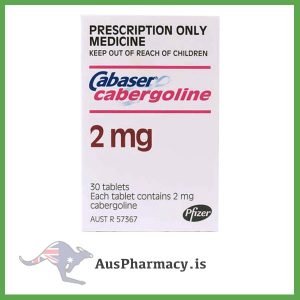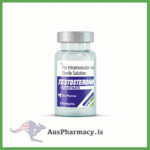Cabergoline Tablets: An Educational Insight into Dopamine Agonists and Endocrine Pharmacology
Introduction
Cabergoline, a potent dopamine receptor agonist, holds an important position in the field of endocrine pharmacology and neuroendocrine education. It is widely studied in Australia and internationally for its role in inhibiting prolactin secretion, which makes it a valuable educational model for understanding pituitary gland function, dopaminergic signaling, and hormonal feedback mechanisms.
This guide explores Cabergoline’s pharmacological significance in an educational context — focusing on its mechanism of action, pharmacokinetics, and academic applications in teaching hormonal and neurochemical regulation.
1. Understanding Cabergoline in Education
Cabergoline is classified as a dopamine D2 receptor agonist, meaning it mimics dopamine’s natural activity in the brain. In pharmacology programs, especially in Australia, it’s used as a learning reference for how synthetic compounds can regulate neurotransmitter-controlled hormones like prolactin.
In an academic setting, Cabergoline is an ideal case study for illustrating how targeted receptor therapy can restore physiological balance — a cornerstone principle in clinical pharmacology.
2. Pharmaceutical Background and Chemical Properties
Cabergoline is a semi-synthetic ergot derivative, structurally related to other dopaminergic drugs but with enhanced selectivity for D2 dopamine receptors.
Educational discussions often include its chemical composition, lipophilicity, and long duration of action — all valuable topics in pharmaceutical chemistry and formulation science.
By examining Cabergoline’s molecular design, students gain insights into structure-activity relationships (SAR) and drug development strategies.
3. Mechanism of Action (Academic Analysis)
Cabergoline’s educational significance lies in its ability to inhibit prolactin secretion from the anterior pituitary gland. It achieves this by stimulating dopamine D2 receptors in the hypothalamus, which suppress the release of prolactin.
From an educational perspective, this process helps students visualize how neurotransmitters regulate endocrine hormones, reinforcing the connection between the central nervous system and the endocrine system.
In pharmacology courses, this mechanism is used to teach:
-
Dopamine receptor signaling
-
Negative feedback control in hormone release
-
Pharmacodynamic modulation of pituitary hormones
4. The Role of Dopamine in Hormonal Regulation
Dopamine is one of the most critical neurotransmitters studied in neuroendocrine pharmacology. It plays roles in mood, motivation, motor control, and hormone regulation. Cabergoline acts as a teaching model for understanding dopamine’s inhibitory influence on prolactin secretion.
By exploring Cabergoline, students can map how chemical messengers affect different physiological pathways — a vital learning outcome in pharmacology programs across Australia and beyond.
5. Academic Use in Pharmacology and Medical Education
Cabergoline’s role in education goes beyond theoretical learning. In medical, pharmaceutical, and biological sciences, it’s used to demonstrate the clinical relevance of dopamine agonists and hormonal feedback loops.
Educators use Cabergoline case studies to:
-
Illustrate pharmacodynamics of receptor agonists
-
Teach endocrine regulation of lactation and fertility
-
Analyze side effects and safety considerations
Through simulation models and e-learning tools, students explore how the body responds to exogenous dopamine agonists, deepening their understanding of systemic regulation.
6. Pharmacokinetic Profile (Educational Perspective)
Students studying Cabergoline analyze its pharmacokinetics to understand its long-acting nature and therapeutic efficiency:
-
Absorption: Rapid and consistent after oral administration
-
Metabolism: Hepatic via cytochrome P450 enzymes
-
Half-life: 63–68 hours (one of the longest among dopamine agonists)
-
Excretion: Through fecal and urinary pathways
These parameters help learners grasp essential concepts such as drug half-life, plasma binding, and dose scheduling — core competencies in pharmaceutical education.
7. Educational Comparison: Cabergoline vs. Bromocriptine
Students often compare Cabergoline with Bromocriptine, another dopamine agonist.
Cabergoline’s longer half-life and greater receptor selectivity make it a superior model for sustained-release pharmacology discussions.
This comparative analysis enables learners to understand drug optimization, patient compliance, and pharmacoeconomic evaluation, vital topics in pharmacology and pharmaceutical management education.
8. Applications in Research and Academic Study
Cabergoline serves as a research tool in various academic fields, including:
-
Endocrinology research: To study prolactin suppression mechanisms.
-
Neuropharmacology: To examine dopaminergic pathway responses.
-
Pharmaceutical formulation: To test controlled-release tablets and bioavailability.
In Australian universities, Cabergoline’s inclusion in research papers and case studies makes it a valuable educational reference for understanding neurohormonal pharmacodynamics.
9. Reproductive and Endocrine Education
Cabergoline is studied in reproductive pharmacology modules to demonstrate how prolactin influences menstrual function and lactation.
By examining its mechanism, students learn how prolactin excess can cause infertility or galactorrhea — conditions that can be managed through dopaminergic regulation.
This educational approach helps connect hormonal physiology with therapeutic pharmacology, bridging the gap between theory and application.
10. Adverse Reactions and Safety (Learning Context)
In classroom learning, educators use Cabergoline’s known adverse effects as examples for teaching pharmacovigilance and risk assessment.
Common academic discussions include:
-
Nausea and dizziness (dopaminergic stimulation effects)
-
Hypotension (vascular response to dopamine activity)
-
Fatigue or sleep disturbances (CNS effects)
Students analyze case data to understand dose-response relationships and tolerability in pharmacotherapy.
11. Ethical and Regulatory Aspects in Australia
In Australia, Cabergoline is classified as a prescription-only medication, emphasizing the importance of medical supervision.
Educational programs use this regulatory framework to teach ethical prescription practices, pharmaceutical law, and therapeutic governance.
These lessons ensure that future practitioners appreciate the balance between clinical benefit and public safety.
12. Integration into Modern E-Learning Systems
Many universities and pharmacology institutes have integrated Cabergoline-related case studies into digital simulations, interactive hormone maps, and AI-driven pharmacology modules.
Students can simulate dopamine receptor binding, visualize pituitary responses, and analyze pharmacokinetic data — turning theory into an engaging digital learning experience.
13. Educational Relevance in Endocrine Medicine
Cabergoline remains a cornerstone teaching model in endocrine medicine and neuropharmacology.
Its study enhances understanding of:
-
Hormonal balance in the pituitary axis
-
Neurotransmitter-endocrine interactions
-
Long-term drug regulation systems
By mastering these topics, students build a solid foundation in both clinical and theoretical pharmacology.
14. Future of Dopamine Agonist Research (Academic Outlook)
With advancements in receptor-targeted therapy, Cabergoline continues to serve as a benchmark for developing next-generation dopamine agonists.
Students studying drug design can explore how molecular optimization enhances receptor specificity, tissue selectivity, and pharmacological outcomes — paving the way for safer, more effective medications.
15. Conclusion
Cabergoline Tablets offer much more than a clinical function — they represent a key educational tool for understanding the neuroendocrine system, dopamine pharmacology, and hormonal feedback regulation.
For educators and students in Australia, Cabergoline serves as an exemplary study material to explore how one compound can influence an entire hormonal axis through targeted receptor activity.
By integrating it into pharmacology, physiology, and medical training, learners develop a comprehensive understanding of endocrine control, drug action mechanisms, and ethical pharmacotherapy principles.
In education, Cabergoline stands as a symbol of how science, pharmacology, and ethical awareness converge to promote informed and responsible medical knowledge.






